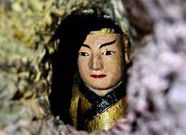Chile unveils world's largest astronomical observatory
(Xinhua) 08:22, March 14, 2013 

Chile unveils world's largest astronomical observatory in the remote Atacama Desert of the northern Chilean Andes on March 13, 2013. (Photo/Xinhua)
【1】 【2】 【3】 【4】 【5】 【6】 【7】 【8】 SANTIAGO, March 13 (Xinhua) -- Chilean President Sebastian Pinera Wednesday presided over the launching of the world's largest astronomical observatory in the remote Atacama Desert of the northern Chilean Andes.
Home to the world's most powerful telescope, the Atacama Large Millimeter/submillimeter Array(ALMA), the observatory is the result of a collaboration between Europe, the United States, Japan and Chile, according to an ALMA press release.
"One of our many natural resources is Chile's spectacular night sky," Pinera told the more than 500 guests gathered for the event.
"I believe that science has been a vital contributor to the development of Chile in recent years. I am very proud of our international collaborations in astronomy, of which ALMA is the latest and biggest outcome." said Pinera
Located 5,000 meters above sea level, the assembly of ALMA's antennas was recently completed and the telescope has already provided "unprecedented views of the cosmos with only a portion of its full array," the observatory said.
ALMA "is able to observe the universe by detecting light that is invisible to the human eye (and) will show us never-before-seen details about the birth of stars, infant galaxies in the early universe, and planets coalescing around distant suns," the observatory added.
Already "astronomers are having to rewrite a major part of the history of the universe," the observatory said, because the telescope has shown that the strongest star bursts in the cosmos " took place much earlier than previously thought." Those results will appear in the March 14 edition of the journal Nature.
ALMA Director Thijs de Graauw said the telescope "dwarfs anything else we had before," adding "we are eager for astronomers to exploit the full power of this amazing tool."
The antennas of the ALMA array, 54 12-meter dish antennas and 12 smaller 7-meter dish antennas, work together as a single telescope. Each collects radiation coming in from space and the data is brought together and processed by a specialized supercomputer.
Pinera, as the event's guest of honor, instructed the researchers inside the observatory to turn on the telescopes, which then rotated to point towards the sky.
The observatory cost approximately 1.5 billion dollars, derived in part from the European Southern Observatory, the U.S. National Science Foundation and Japan's National Institutes of Natural Sciences.
As part of the inauguration ceremony, the Atacama indigenous group performed a ceremony requesting the permission of "Pachamama, " or Mother Nature, to make use of the site.
(Editor:WangXin、Wang Jinxue)



 Naval escort taskforce in drill to rescue hijacked ship
Naval escort taskforce in drill to rescue hijacked ship  New guided missile frigate is commissioned to Navy
New guided missile frigate is commissioned to Navy Kashmiris mourn over death of truck driver
Kashmiris mourn over death of truck driver Canberra celebrates its 100th birthday
Canberra celebrates its 100th birthday Flight attendants recruitment attracts young
Flight attendants recruitment attracts young Year's first rainfall for Beijing
Year's first rainfall for Beijing China's weekly story (2013.2.28-3.8)
China's weekly story (2013.2.28-3.8) Cold front brings heavy snowfall to Shenyang
Cold front brings heavy snowfall to Shenyang A visit to 200-year-old Xiwan residence in Qikou
A visit to 200-year-old Xiwan residence in Qikou Statue of ideologist Zhu Xi set inside ancient camphor tree
Statue of ideologist Zhu Xi set inside ancient camphor tree  Pure land on earth: Shijing Temple in Chengdu
Pure land on earth: Shijing Temple in Chengdu Qinghai Lake's coverage expands due to protection
Qinghai Lake's coverage expands due to protection  South Africa is ready for BRICS
South Africa is ready for BRICS Top 10 Chinese cities with highest urbanization quality
Top 10 Chinese cities with highest urbanization quality  People bid farewell to Ministry of Railways
People bid farewell to Ministry of Railways